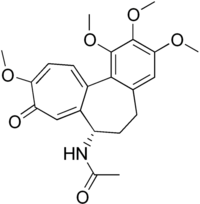Colchicine
From CreationWiki, the encyclopedia of creation science
Jump to navigationJump to search
Colchicine is a highly poisonous alkaloid, originally extracted from Colchicum plants. It is a substance which inhibits the polymerization of the proteins of the mitotic spindle, stopping cell division in metaphase. It was first used in cytogenetic studies during the 50s. Once inactivated by binding to cochicine, the tubulin protein can no longer be assembled into microtubules, and therefore, can no longer function as a control mechanism for the chromosomes, resulting in halting of the nuclear division.[1] Colchicine is routinely used to test whether microtubules are required for a given biological process.[2]
In medicine, colchicine is used to treat gout.
References
- ↑ Clark, M. S.; Wall, W. J (1996). Chormossomes: The Complex Code. London: Chapman & Hall. p. 2. ISBN 0-412-75210-7.
- ↑ Alberts, Bruce; Johnson, Alexander; Lewis, Julian; Raff, Martin; Roberts, Keith; Walters, Peter (2008). Molecular Biology of the Cell (5th ed.). New York and London: Garland Science. p. 527. ISBN 0-8153-4105-9.
| ||||||||||||||

